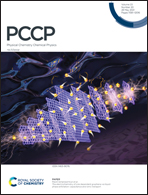Outstanding spin-transport properties of a flexible phosphorene photodetector driven by the photogalvanic effect under mechanical strains
Abstract
Monolayer phosphorene has outstanding spintronic properties including a nanosecond spin lifetime, and micrometer spin relaxation length, combined with excellent mechanical flexibility, making it rather attractive in low-dimensional flexible spintronic devices. However, knowledge on the spin-transport properties of phosphorene under mechanical strain is currently very limited. Here, we study the transport properties of the spin-polarized photocurrent in the flexible Ni–phosphorene–Ni photodetector, which is driven by the photogalvanic effect (PGE) under mechanical tension stress and bending. Broadband PGE photocurrent is generated at zero bias under the illumination of linearly polarized light due to the broken inversion symmetry of the photodetector. Remarkable spin-transport performances including the fully spin-polarized photocurrent, perfect spin-valve effect, and enhanced pure spin current are generated in a broad visible range by applying appropriate mechanical tension stress or bending. Our results indicate that the PGE-driven phosphorene-based photodetector has promising applications in flexible and low-power spintronic devices.



 Please wait while we load your content...
Please wait while we load your content...